jameson_uk
Member
TLDR: I need suggestions on why Amazon Frogbit died and how to get tank back on track
I have a Rio 180 tank with the stock 2x45W T5 tubes running in an otherwise low tech setup. It is reasonably well planted (Amazon Swords, Crypts, Rotalia, Fotala, Anubias and Java Fern) just adding Flourish once a week and Tropica root tabs (mainly micro plus a little macro I believe) where appropriate once every six weeks or so.
The tank has been setup for nearly five months and whilst I have had a few issues with plants not growing that well (http://www.ukaps.org/forum/threads/deficiencies.42284/) they have been not that bad. I upped the lighting to a contiguous 8 hours a day (from 2 x 3 hours) and the plants looked a bit healthier and I have had to trim the stem plants quite a bit and the swords look a little healthier and there is generally growth everywhere.
From other threads I realise this is probably too much light but as the lights are built into the lid there is little I can do about this until I can afford to look at other options (the T5s are an odd length to only a couple of possible replacements and these are still 45W and you cannot run the unit with just one tube).
The frogbit I added about four months ago has been growing pretty well and I have been using this to diffuse the light and has been doing pretty well. I put in about 10 medium plants and these all grew and spread quite well to cover about 20-25% of the surface but started dying off a few weeks ago it looked like
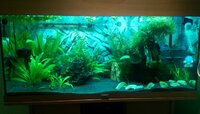
The plants still looked relatively healthy but lots of leaves were falling off some of which looked perfectly healthy, others has basically decomposed and others looks like they had chunks taken out of them. I suspected some of this was down to flow and the leaves being forced under water and rotting so I had tried a few things to keep them out of the main flow from the spray bar without much change.
I have come back from a week's holiday and a significant amount of frogbit seems to have disappeared (probably covers less than 5% now)

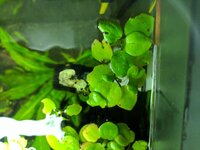
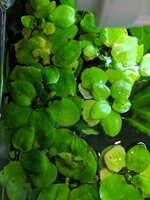
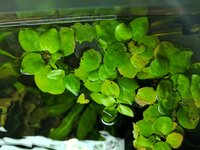
On top of this I have a lot more algae than I had before.
I have not really had any algae of note on the front glass (and the small amount that was there previously was quickly removed by the Otos). There is now a fair amount of green algae and the dark dots are what I believe are tufts of BBA.
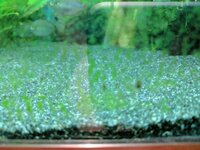
On top of this the Java Moss which has been fine has developed a mass of thread algae
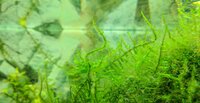
which has basically developed over the last week.
Some of the fish have been suffering from Flavobacterium columnare (Cottonmouth) which had a few impacts starting two weeks ago
The in-laws popped round on Wednesday and fed them (amounts I have already measured out).
Today I got back and found one of the rainbowfish dead (looks like it was one that had the bacterial infection) and all this algae....
So what looks to have happened to the frogbit and why was it OK until a few weeks ago?
Going to be a doing a fair bit of maintenance tomorrow and will try and remove as much algae as I can but could do with understanding that is going on...
I have a Rio 180 tank with the stock 2x45W T5 tubes running in an otherwise low tech setup. It is reasonably well planted (Amazon Swords, Crypts, Rotalia, Fotala, Anubias and Java Fern) just adding Flourish once a week and Tropica root tabs (mainly micro plus a little macro I believe) where appropriate once every six weeks or so.
The tank has been setup for nearly five months and whilst I have had a few issues with plants not growing that well (http://www.ukaps.org/forum/threads/deficiencies.42284/) they have been not that bad. I upped the lighting to a contiguous 8 hours a day (from 2 x 3 hours) and the plants looked a bit healthier and I have had to trim the stem plants quite a bit and the swords look a little healthier and there is generally growth everywhere.
From other threads I realise this is probably too much light but as the lights are built into the lid there is little I can do about this until I can afford to look at other options (the T5s are an odd length to only a couple of possible replacements and these are still 45W and you cannot run the unit with just one tube).
The frogbit I added about four months ago has been growing pretty well and I have been using this to diffuse the light and has been doing pretty well. I put in about 10 medium plants and these all grew and spread quite well to cover about 20-25% of the surface but started dying off a few weeks ago it looked like

The plants still looked relatively healthy but lots of leaves were falling off some of which looked perfectly healthy, others has basically decomposed and others looks like they had chunks taken out of them. I suspected some of this was down to flow and the leaves being forced under water and rotting so I had tried a few things to keep them out of the main flow from the spray bar without much change.
I have come back from a week's holiday and a significant amount of frogbit seems to have disappeared (probably covers less than 5% now)




On top of this I have a lot more algae than I had before.
I have not really had any algae of note on the front glass (and the small amount that was there previously was quickly removed by the Otos). There is now a fair amount of green algae and the dark dots are what I believe are tufts of BBA.

On top of this the Java Moss which has been fine has developed a mass of thread algae

which has basically developed over the last week.
Some of the fish have been suffering from Flavobacterium columnare (Cottonmouth) which had a few impacts starting two weeks ago
- Did a couple of fairly big water changes (which brought nitrates down to about 10ppm)
- Treated with Interpet No 8 (Anti-fungal & finrot) which is also apparently anti-bacterial. This did not go too well and it knocked a lot of the fish out so ended up doing another fairly big water change and I think Nitrates dropped to 5ppm)
- Dropped the temperature down to about 23.5C (apparently this stops the spread of the bacteria)
- Removed the Purigen that was in the canister
The in-laws popped round on Wednesday and fed them (amounts I have already measured out).
Today I got back and found one of the rainbowfish dead (looks like it was one that had the bacterial infection) and all this algae....
So what looks to have happened to the frogbit and why was it OK until a few weeks ago?
Going to be a doing a fair bit of maintenance tomorrow and will try and remove as much algae as I can but could do with understanding that is going on...
- Could the reduction in Phosphate (only been fed twice this week) cause an issue?
- Is there an obvious deficient you can see from the frogbit pictures (I did see Iron mentioned somewhere)
- Could the big reduction in nitrates have caused an issue (had been staying fairly static about 20ppm)
- Could the removal of the Purigen actually helped the algae?



 .
.